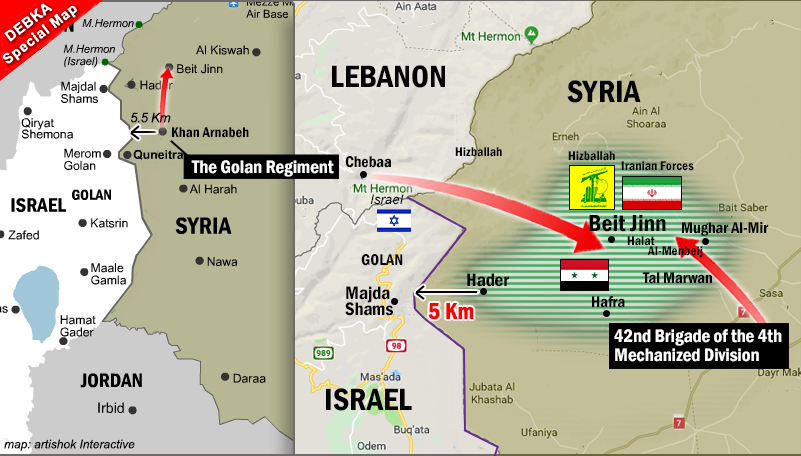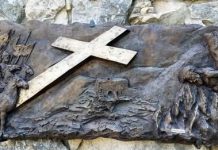Hezballah-Iranian-led force, now 5km from Israeli border
قوات إيران وحزب الله باتوا في سوريا على بعد 5كلم من الحدود الإسرائيلية
DebkaFile/December 25/17
The strategic Beit Jinn enclave was allowed to fall and the Syrian rebel defenders to capitulate – without IDF intervention.
The Syrian-Hizballah-Iranian led attackers completed their capture of the Beit Jinn enclave on Tuesday, Dec. 26, forcing the Syrian rebel defenders to capitulate and gaining close access to Israel’s northern border and the Quneitra pocket of the Golan. For their final push, the attackers were reinforced Sunday by Hizballah troops from Lebanon and the Syrian army’s Golan Regiment militia. On Monday, leaders of the rebel militia holding Beit Jinn met with Syrian and Hizballah officers and signed the following note of surrender:
Full reconciliation is granted to militants native to the Beit Jinn region who wish to stop fighting. Militants who refuse the reconciliation offer are to be transported to rebel-held areas in the Daraa and Idlib Governorates.
Militants who entered the Beit Jinn region through Israeli-controlled territory via Daraa are to exit back to Daraa through the same route. The Syrian Arab Army will regain control over all military sites and bases in the Beit Jinn valley that it possessed prior to the beginning of the civil war in 2011. The terms of the surrender are to be implemented on Tuesday the 26th of December, 2017.
As DEBKAfile reported on Monday, the IDF’s failure to force Druze inhabitants of the Golan village of Hader to open up a southwesterly escape route, would force the embattled Beit Jinn rebels to surrender and negotiate terms for their retreat. Since there was no IDF intervention, the rebels had no option but to bow to the terms dictated by Syrian, Hizballah and Revolutionary Guards officers, and let them move into to positions 6km from the Golan border. No impediment now remains in the path of the three hostile forces for heading towards Israeli Golan. Furthermore, by allowing its allies to lose control of Beit Jinn, Israel virtually signed away military control of the Quneitra pocket. It may be recalled that in October 1973, the Syrian army launched its Yom Kippur offensive for the conquest of northern Israel from this very location.
On Monday, DEBKAfile reported:
The Syrian-Hizballah-pro-Iranian force gain reinforcements from Lebanon and Syria to complete the successful bid for Beit Jinn and close in on Israel. The Beit Jinn enclave faces the IDF’s Mt. Hermon positions and is 11 km from the Israeli border. Its fall is critical to the fate of the Quneitra region opposite the Israeli Golan. Three strategic setbacks confronted Israel on Sunday, Dec. 25 in the wake of the tripartite military’s capture of Maghar Al-Mir (see attached map) which split the Beit Jinn enclave in two.
Syrian and Hizballah forces continued to push forward east and south, while their officers pinned the defenders, the Islamist Hayat al-Tahrir al-Sham rebels, to the wall with an ultimatum: Hand over the fighters accused of ties with Israel in return for a safe passage of retreat from the embattled enclave, or face destruction.
The attackers mobilized reinforcements from a new direction – Lebanon. A column of Hizballah forces drove in Sunday, Dec. 24, from the southern Lebanese outpost of Chebaa and crossed into Syria to join the assault on the rebels.
Damascus, moreover, sent in the Golan Regiment militia to clinch the Beit Jinn battle, in the expectation that its fall would also have a domino effect on Israeli-backed rebel defenders in the entire Quneitra region of the Syrian Golan. The Syrian army originally established this militia for pro-Assad Druze fighters. But in the past year, it has been packed with Iranian elements linked to the Revolutionary Guards. They established a headquarters at Khan Arnaba north of Quneitra and 5km from the Israeli border. The Revolutionary Guards officers’ presence in Khan Arnaba gives Iran a direct hand in the Beit Jinn battle and its projected sequel, the fight for Quneitra right up to Israel’s Golan border and a threat to the IDF’s Hermon position.
DEBKAfile’s military sources estimate that the only way the rebels can escape the Syrian-Hizballah crunch is by going on the offensive against the Druze village of Hader in order to break open an escape route to the southwest. But the obstacle there is a pledge which Israel gave Israeli Druze leaders in November not to allow rebel forces to attack Hader. The pledge was given in the wake of violent Druze riots on the Golan and threats from Israeli Druze, some of whom hold high military ranks in the IDF, to cross the border and defend Hader themselves.
This Israeli pledge to its Druze citizens is the strongest card the Syrian, Hizballah and Iranian forces are wielding to compel the Hayat al-Tahrir al-Sham to surrender. After that, the three forces would move in and take up positions in the captured Beit Jinn enclave, and gain a jumping-off pad against Israel and its Hermon outpost. The way this affair is playing out makes naught of Israel’s government and military leaders’ solemn vow to keep Iran and Hizballah far from its borders.






















